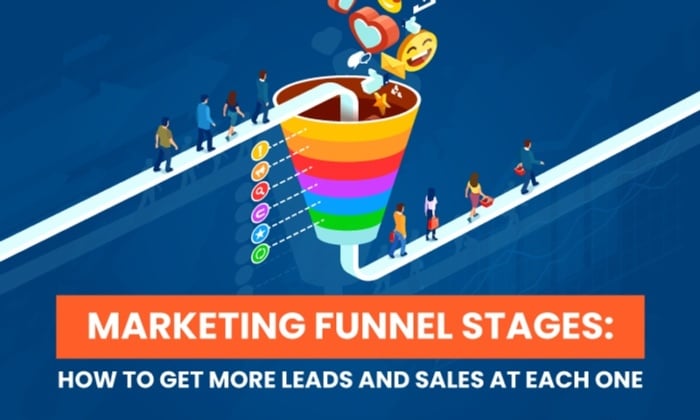
Do you know what your marketing funnel looks like?
If not, you’re likely losing out on leads and sales. According to data from Salesforce, 68 percent of companies have not even identified their marketing funnel. Those that do stand to see results, though. For example, according to Semrush, 72 percent of marketers who create “how-to” guides as a top-of-funnel strategy see success.
In this blog post, we’ll discuss the different stages of the marketing funnel and what you need to do to increase leads and sales at each one. Plus, we’ll cover marketing funnel tips to help you convert more leads.
What Are the Marketing Funnel Stages?
Many brands have their own versions of marketing funnel stages. For example, HubSpot’s Flywheel model has gained popularity in recent years.
For the purpose of this post, here are the main stages of the marketing funnel:
- Top of Funnel: Awareness/Attention
- Middle of Funnel: Interest/Consideration
- Bottom of Funnel: Intent/Action
- Post Funnel: Loyalty/Advocacy
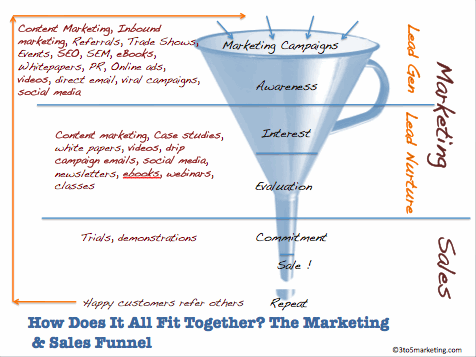
1. Awareness/Attention
Awareness is the first stage of the marketing funnel, and it’s an important one. According to a Content Marketing Institute survey, 88 percent of marketers feel content marketing is most effective for brand awareness.
Brand awareness is when potential customers become aware of your brand or product. For example, they may see one of your ads on social media or come across your website in the search results.
At the awareness stage, you want to focus on getting your brand in front of as many people as possible. You can do this through activities like content marketing, search engine optimization (SEO), social media marketing, and paid advertising.
2. Interest/Consideration
The second stage of the marketing funnel is interest or consideration. In this marketing funnel stage, potential customers are aware of your brand and are starting to learn more about it. They may have read one of your blog posts, watched a video about your product, or visited your website.
At this stage, you want to continue providing potential customers with valuable content to help them learn more about your product or service. You can do this through blog posts, videos, infographics, case studies, ebooks, and webinars.
3. Intent/Action
The third stage of the marketing funnel is intent or action. In this marketing funnel stage, potential customers are interested in your product or service and considering making a purchase. They might add your product to their cart or request more information in the form of a demo.
4. Loyalty/Advocacy
The fourth and final stage of the marketing funnel is loyalty or advocacy. Per the Content Marketing Institute Survey, 78 percent of marketers think one of the most effective uses of content marketing is brand loyalty.
At this stage, customers have made a purchase and are now using your product or service. At this stage, it’s important to continue providing your customers with valuable content and support. This will ensure they remain loyal advocates for your business.
4 Top of Marketing Funnel Strategies
The top of the marketing funnel is where you generate awareness and interest in your product or service. These are often called TOFU strategies (top-of-funnel).
According to Semrush, 95 percent of marketers focus on TOFU strategies, making this stage of your marketing funnel the most popular.
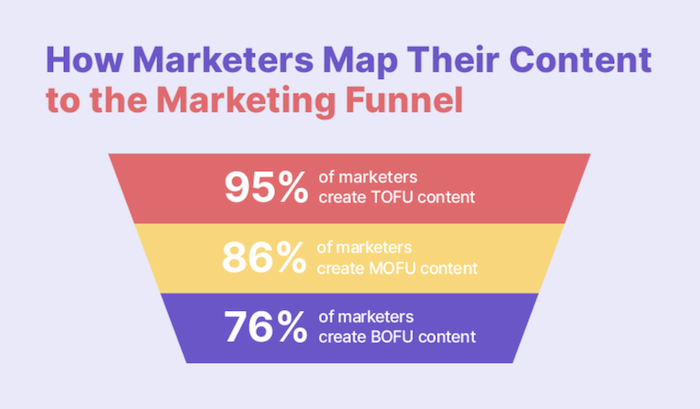
The goal at this stage is to reach as many potential customers as possible and get them interested in what you have to offer.
Top-of-funnel KPIs include:
- traffic sources
- organic sessions
- ad impressions
- ad frequency
- pages per session
Some of the best content types for this stage are blog posts, social media content, videos, and paid digital ads.
When creating content for the top of the marketing funnel stages, focus on generating awareness and interest. This means your content should be educational and informative. You can also use humor and storytelling to capture attention.
Remember, the goal at this stage is not to sell your product or service, but rather to get people interested in what you have to offer. By creating interesting and informative content, you’ll generate more leads and sales at each stage of your marketing funnel.
1. Share Your Brand Story on Social Media
Your brand story is the foundation of your marketing funnel. It is the narrative you want people to associate with your products, services, and marketing.
Studies show brand stories drive ROI. Data from Headstream found 55 percent of people are more likely to buy from a brand if they like its story. On top of that, 44 percent will share that story with others in the future.
Sharing your brand story can take a variety of formats You can write blog posts or create social media content that tells how you were founded. You can also make videos or podcasts that show off your brand’s personality.
When sharing your story, make sure it’s authentic, relatable, and interesting. Share stories that highlight your company culture, values, and mission.
For example, Patagonia is a brand known for its commitment to environmental causes. Their story is one of adventure, exploration, and conservation.
This brand story has helped them attract a customer base that is passionate about the outdoors and cares about sustainability.
People buy from them not just because their products are good, but because they believe in who Patagonia is as a brand.
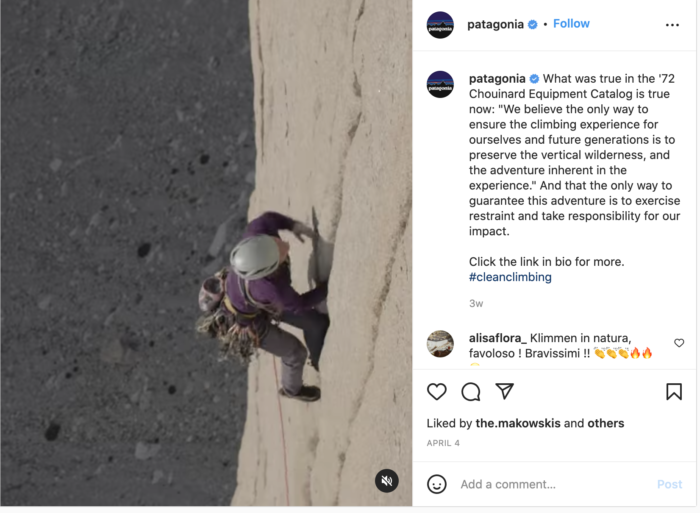
2. Become an Advocate for Causes Your Brand and Customers Care About
A study by Edelman Earned Brand found values-based communication is as effective as product-based communication in driving purchase intent.
This means when you advocate for causes your customers care about, you’re more likely to earn their business.
For example, Toms is a company built on the idea of giving back. They invest 1/3 of their profits into grassroots organizations focused on driving sustainable change.
Toms has become a billion-dollar company by marketing to people who want to make the world a better place.
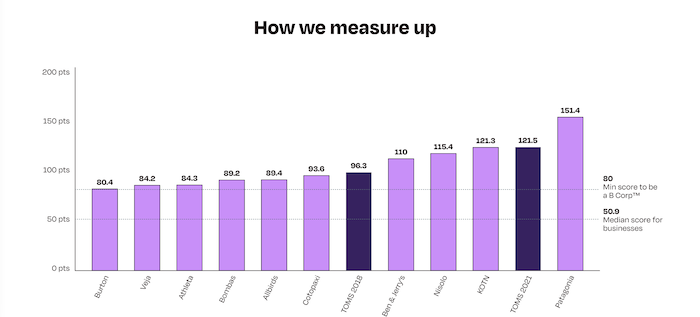
You can do the same thing by finding causes your target market cares about and supporting them through marketing initiatives.
It could be anything from environmentalism to social justice.
The important step is to align your marketing efforts with causes your target market feels passionate about and show you care, too.
This makes it more likely they’ll do business with you and improves the likelihood that they’ll become brand advocates and promote your business to their friends and family.
Do you know what causes your target market cares about?
3. Run Paid Ads
Paid ads are an essential part of your digital marketing funnel. Not only do they help you to reach a wider audience, but they can also target specific demographics, interests, and even locations.
In fact, research from eMarketer found paid advertising is a failsafe way to increase your brand awareness.
There are a variety of paid ad options for your top of funnel marketing strategy, including:
- ads on podcasts
- YouTube ads
- ads on social media
- Google ads
When choosing which platforms to advertise on, consider where your target audience spends their time online. This research will ensure you’re not wasting your marketing budget on ads that no one engages with.
For example, if you’re targeting young adults, then focus your paid ad strategy on platforms like Snapchat and Instagram. However, if you’re targeting an older demographic, Facebook and LinkedIn would be better options.
Once you’ve determined which platforms to use, design your ads with brand awareness in mind.
This might mean creating an ad that tells a story or using emotionally-driven language. The goal is to get potential customers interested in your product or service so they move further down your marketing funnel stages.
4. Build SEO-Rich Blogs
Studies show 60 percent of customers say blog posts are valuable in the early marketing funnel stages.
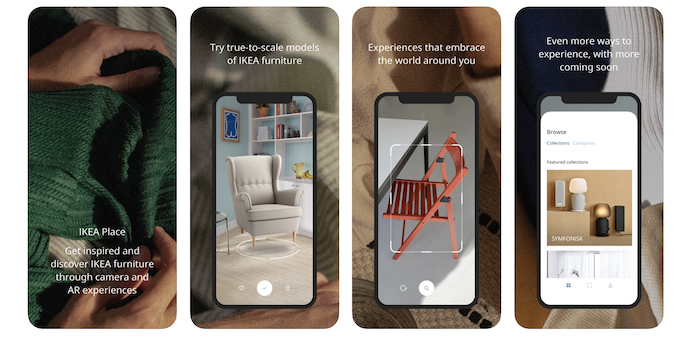
Blogs are an effective way to generate leads because they allow you to show off your industry expertise and attract readers who might not be familiar with your brand.
To make your blog posts more effective, include relevant keywords throughout the content.
This will improve your search engine ranking so people will find your blog when they’re looking for information on the topics you write about.
In addition, include calls-to-action (CTAs) throughout your blog post.
A CTA is a prompt that encourages readers to take a specific action, such as visiting your website, signing up for a newsletter, or downloading a white paper or e-book.
By including CTAs, you can guide readers to the next stage in their buyer journey, moving them down your marketing funnel stages.
To improve your blog ranking further, check out these tips on how to rank a blog.
4 Middle of the Marketing Funnel Strategies
The middle stage of your marketing funnel is all about nurturing leads and getting them closer to a purchase decision. It’s also about filtering out leads that aren’t a good fit. This stage is also referred to as MOFU (middle-of-funnel).
At this point, your KPIs focus on cost efficiencies. You don’t want to throw content at someone who isn’t interested, so your placements need to be more personalized.
Middle funnel KPIs include:
- direct message replies
- app installs
- downloads
- lead volume
You’ll also want to think about ways to keep customers coming back for more.
Some strategies to use during this stage include:
- Creating lead magnets, such as ebooks or white papers that require an email address for download.
- Offering free trials or demos of your product.
- Developing email marketing campaigns to keep leads engaged.
- Creating retargeting ads for people who have visited your site but haven’t converted.
Here are four strategies you can use to get more leads and sales in the middle stage of your marketing funnel.
1. Create FAQ Content
Frequently asked questions are crucial for content marketing in the middle stage of your marketing funnel.
Not only do FAQ pages address user concerns and hesitations, but they can also be a great way to target specific keywords in search.
To find questions your target customers are asking, you can use keyword research tools like Ubersuggest.
You can also look for questions being asked on social media and forums related to your industry. Searching popular industry hashtags will help you find those questions. Google’s “people also ask” questions are another source of inspiration.
Once you’ve compiled a list of questions, start brainstorming related questions your target customers are likely to ask at this stage.
From there, you can create blog posts, infographics, or even videos that answer these questions. You can also create a stand-alone FAQ page on your website.
Not only will FAQs attract leads further down the marketing funnel, they can also help you attract organic traffic from search engines.
2. Include Case Studies on Your Website
According to HubSpot, 13 percent of marketers say case studies are one of the main forms of content that are used in their marketing strategy.
This makes case studies the fifth most popular type of content, only behind visual content, blogs, and ebooks.
If you’re not already using case studies on your website, now is the time to start.
Case studies nurture customers in the middle of your digital marketing funnel by providing real-world examples of how your product or service helps businesses achieve their goals.
This establishes trust and credibility, which are essential if you want to convert leads into customers.
You can also use case studies in paid ad campaigns to further increase conversion rates.
Check out the video below to learn more about crafting effective case studies.
3. Leverage Retargeting
How can you find interested leads if they haven’t contacted you first?
Remarketing (or retargeting) is a marketing technique that shows your ads to people who have already engaged with your brand in some way. Maybe they’ve visited your website or followed you on social media.
To leverage this strategy, you’ll need to install a pixel from an ad platform on your website that allows you to track visitors as they move around the internet. Here’s how to get started with Facebook retargeting and Google Ads retargeting.
Once you have the pixel installed, you can create targeted ads that will follow your leads as they surf the web.
For example, you could create an ad promoting your product to people who visited your website but didn’t make a purchase.
Or, you could offer a discount to people who visited your website in the past week.
Installing a pixel on your website is an extremely effective way to keep your brand top-of-mind in the middle of your funnel. It can also increase the chances leads will come back to your website and convert into customers.

As you can see, remarketing can be used at any stage of the marketing funnel.
4. Showcase Customer Stories
Research shows 40 percent of customers follow brands based on recommendations from friends or family. As well, 91 percent read online reviews before making a purchase.
That is the power of social proof. One of the best ways to show social proof is through customer stories.
These can take the form of testimonials on your website, or reviews on product pages.
You can also create more in-depth case studies showing how your product or service helped a customer achieve their goals.
For example, ClearVoice has a dedicated Customer Stories page on its website, which features in-depth interviews with customers about how they use the platform to drive results.

This strategy not only builds social proof but also increases your credibility and authority.
Not to mention, when prospects see you’re a credible and trustworthy company, they’ll be more likely to do business with you.
4 Bottom of the Marketing Funnel Strategies
Bottom-of-funnel strategies (or, BOFU) are all about conversion.
At this stage, your goal is to get prospects to take the desired action, whether that’s signing up for a free trial, subscribing to your email list, or making a purchase.
KPIs at the bottom of the marketing funnel include:
- conversions
- sales
- store visits
- customer lifetime value
Here are four strategies you can use to drive conversions at the bottom of your marketing funnel.
1. Create a Demo of Someone Using Your Product
Once your customers reach the bottom of your marketing funnel, they should have a very clear idea of what value you deliver.
They are likely interested in trying your product but may be hesitant to commit to a purchase without seeing it in action first.
One way to ease their concerns and increase the likelihood of conversion is to create a demo of your product in use.
This could be a video or an interactive tool that simulates the experience of using your product.
For example, if you’re selling a clothing item, let your customer see what it looks like on their body. Gucci did this using Snapchat’s AR filters to show customers what their shoes would look like on their feet.

You can also try creating an interactive tool that allows users to see what a product would look like in their own home.
IKEA Place lets users place virtual furniture in their own homes to see how it would look.
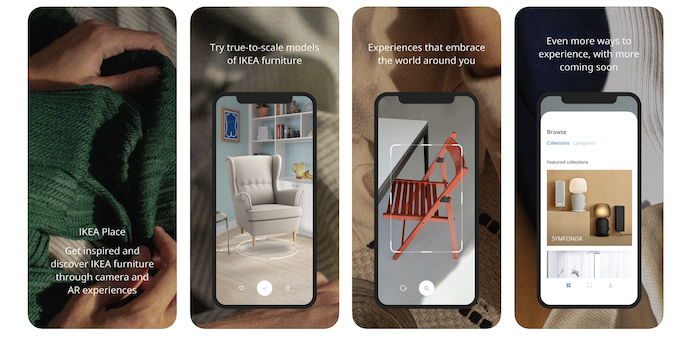
By giving customers a realistic preview of what your product looks like and how it works, you can increase the likelihood that they’ll make a purchase.
2. Publish Highly-Targeted Blog Posts
In the bottom stages of your marketing funnel, you should be focused on providing as much value to your audience as possible.
One way to do this is by publishing blog posts that are highly targeted to their needs and interests.
For example, if you sell software that helps marketing teams track their customer data, you could write a blog post about the importance of data tracking in marketing.
This would be a great resource for marketing teams considering your software, and it would help you generate leads and sales from this stage of the funnel.
You could even take it a step further and speak to direct ways your product has answered a customer pain point.
By providing value to your audience and addressing their specific needs, you can increase the likelihood they’ll make a purchase from you.
Not to mention, data shows marketers who make blogging a priority are 13 times more likely to see positive ROI.
3. Offer Coupons or Discounts
Coupons and discounts are often offered in the middle of your marketing funnel as a way to increase conversions.
Data shows 6 out of 10 free trials convert to paid subscriptions. For B2B businesses, this close rate is even higher, around 66 percent, or 2 in 3 trials converting. B2C tends to sit around 57 percent.
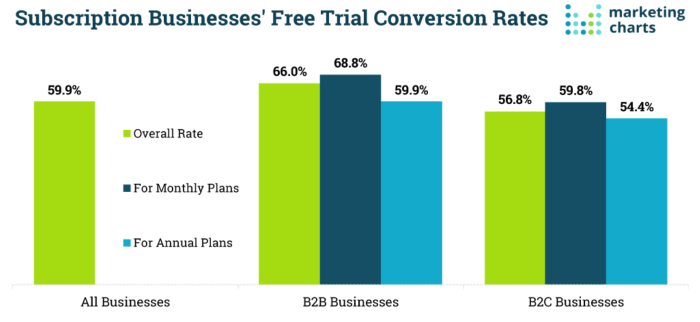
However, what happens if your customer hasn’t had enough time with your product to convert?
Should you cancel the discount and force them off, even if staying longer might result in a purchase?
Of course not.
There’s nothing wrong with extending a coupon or discount if you think the customer may just need a little more time.
It’s better to keep them in your marketing funnel (and eventually convert them) than lose them entirely.
Extending coupons and discounts can be a great way to increase conversions, but only if it’s done at the right time. If you extend too early, you risk losing potential profits.
If you extend too late, the customer may have already made their decision and moved on.
Finding that perfect balance is key to maximizing your marketing funnel’s effectiveness.
4. Make Pricing Clear and Customizable
Once your customer reaches the bottom stages of your marketing funnel, they’re going to be looking for pricing information.
This is where things can get a little tricky. Pricing can make or break a conversion. If a customer feels your price is too high, they may move on to a competitor.
On the other hand, if your pricing is too low, they may question the quality of your product.
The best way to combat this issue is to be as transparent as possible with your pricing.
Make sure all prices are listed clearly on your website or marketing materials. If you offer discounts or free trial options, be sure to list those as well.
You should also give customers the option to customize their order, so they can get exactly what they need.
Designing your pricing page from high to low has also been shown to increase conversions, according to data from the CXL Institute.
Here’s an example of this from WPForms.
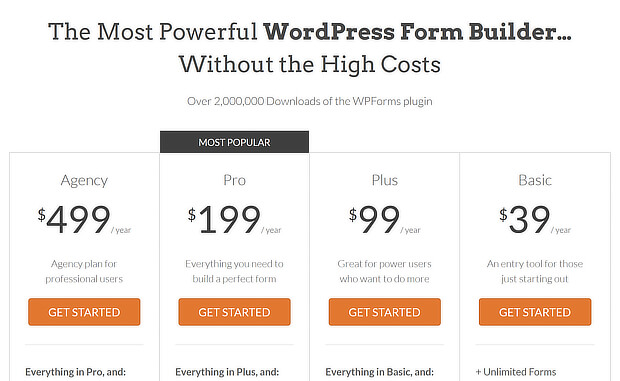
The last thing you want is for a customer to reach the bottom of your marketing funnel only to be confused or turned off by your pricing.
Being upfront and honest about your prices helps prevent potential issues and increases conversions.
Learn how to create a pricing page that converts in this blog.
4 Post Marketing Funnel Strategies
Once customers have converted, your work isn’t done. At this stage, your focus should be on making sure customers are happy so they come back for more—and recommend you to their friends.
Here’s four strategies that help build long-term growth.
1. Use Surveys to Learn More
One of the best ways to improve your marketing funnel stages is to learn how and where your customers get stuck.
Including surveys in your strategy, either on your website, through email marketing, or after a conversion, can give you valuable insights into customer behavior.
For example, a post-purchase survey can measure customer satisfaction and let you know what works in your marketing funnel.
A drop-off survey, say when a customer cancels their subscription or asks for a refund, can help you learn what went wrong so you can improve the customer experience.
You can also use a post-visit survey to see how a customer’s in-store experience went, like in this example from Nordstrom Rack.
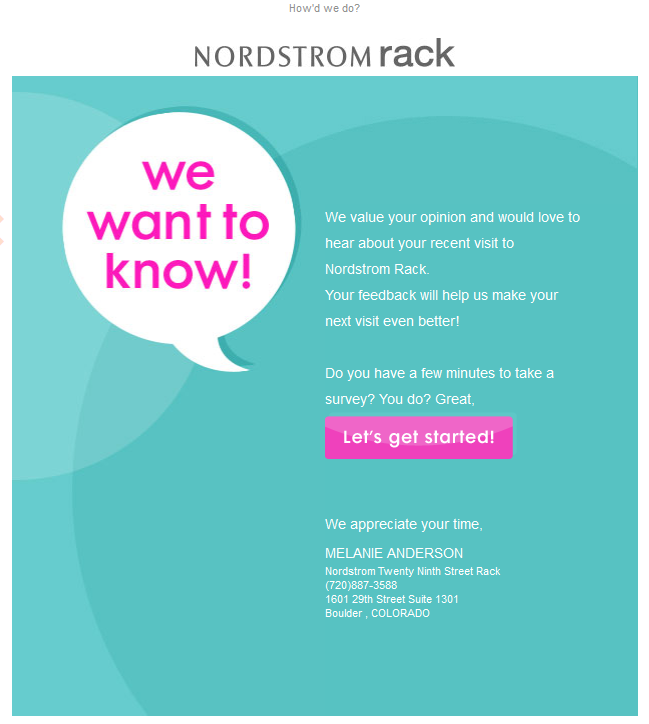
You can also use surveys to segment your audience and create marketing personas.
This way, you can target your marketing more effectively and see better results from your campaigns.
Find online survey creator options here.
2. Implement Session Recordings
If you want to know more about how to improve the customer experience on your site, consider implementing session recordings.
Session recordings show you how customers interact with your website, so you can identify any areas of confusion or frustration.
To get started, all you need is a recording tool like HotJar or Mouseflow.
Once you have recordings of your website traffic, you can begin to analyze them to improve your marketing funnel.
For example, if you want to know how your checkout page is performing, you can create a segment of all users who visited the page and then watch their behavior.
Maybe they get frustrated when they see your shipping prices. Or, maybe they have a hard time finding the coupon code input field.
Identify these issues, then make changes to improve your marketing funnel and increase conversions.
3. Create a Referral Program
At this stage of your marketing funnel, your customers are likely already using your product or service.
A great way to encourage them to continue doing so is to incentivize them with a referral program.
For example, you can offer them a discount on their next purchase for every new customer they refer to your business.
You could also offer a loyalty program that rewards them for continued business.
This is a win-win situation for both you and your customers because they get rewarded for spreading the word about your business, and you get more leads and sales.
This type of program not only keeps your customers coming back, but it also helps you acquire new customers through word-of-mouth marketing.
Check out this referral example from Canadian phone company Koodo, which offers an upfront payment, plus yearly savings for both referral and referee.
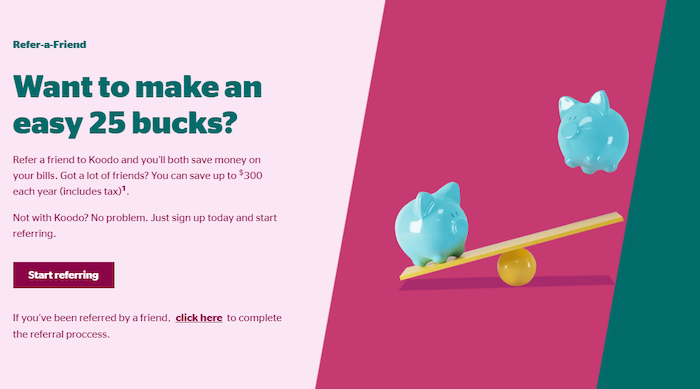
4. Make Customer Service a Priority
Once your customers convert, you may think your work is done.
That’s not the case.
You need to ensure they are happy with their purchase, and this is where customer service comes in.
If you offer excellent customer service, your customers are more likely to do business with you again—and recommend you to others.
On the other hand, if you have poor customer service, you’ll likely lose customers and damage your reputation.
In fact, 68 percent of customers are willing to pay more for products or services that offer good customer service.
Eighty-six percent of customers say good customer service interactions turn them into long-term brand champions.
That’s why it’s so important to make customer service a priority, especially if you want to increase leads and sales from your marketing funnel.
Here are a few ways to improve your customer service:
- Train your employees on how to handle customer inquiries and complaints.
- Respond to customers in a timely manner.
- Offer multiple channels for customer support, such as phone, email, live chat, etc.
- Take feedback from customers seriously and use it to improve your products or services.
Following these tips will ensure your marketing funnel is running smoothly and your customers turn into long-term brand advocates.
Marketing Funnel Stages Frequently Asked Questions
What's the difference between a sales funnel and a marketing funnel?
A sales funnel takes a customer from marketing efforts to a conversion. A marketing funnel is the process of converting a potential lead to a paying customer.
What content types work for all marketing funnel stages?
Content like blogs, explainer videos, ebooks, and webinars can be used at any stage of the marketing funnel.
How long does it take to create a content marketing funnel strategy for each stage?
It can take anywhere from six months or longer to create a comprehensive content marketing funnel strategy. Each stage should be built out separately and then combined to encompass the full funnel.
How many stages are there in a marketing funnel?
There are generally four stages in a marketing funnel: Awareness/Intention, Interest/Consideration, Intent/Action, Loyalty/Advocacy.
Conclusion: Marketing Funnel Stages
Now that you understand all of the digital marketing funnel stages, it’s time to start crafting your strategy.
The first step is to understand who your customers are, what they want, and how you can deliver the experience they want.
From there, start creating content that will guide them through each stage of the marketing funnel.
Remember to tailor your marketing message and strategies to each stage of the marketing funnel for maximum impact.
The sooner you start, the sooner you can generate more leads and drive sales.
What tactics have you found useful in your marketing funnel stages?
from Neil Patel's Digital Marketing Blog https://ift.tt/AgK8VYH
via IFTTT
No comments:
Post a Comment